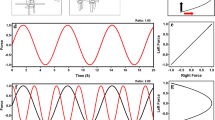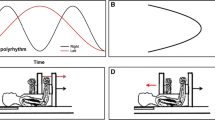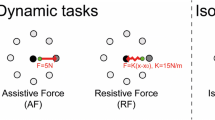Abstract.
In the first of three experiments, 11 participants generated pronation and supination movements of the forearm, in time with an auditory metronome. The metronome frequency was increased in eight steps (0.25 Hz) from a base frequency of 1.75 Hz. On alternating trials, participants were required to coordinate either maximum pronation or maximum supination with each beat of the metronome. In each block of trials, the axis of rotation was either coincident with the long axis of the forearm, above this axis, or below this axis. The stability of the pronate-on-the-beat pattern, as indexed by the number of pattern changes, and the time of onset of pattern change, was greatest when the axis of rotation of the movement was below the long axis of the forearm. In contrast, the stability of the supinate-on-the-beat pattern was greatest when the axis of rotation of the movement was above the long axis of the forearm. In a second experiment, we examined how changes in the position of the axis of rotation alter the activation patterns of muscles that contribute to pronation and supination of the forearm. Variations in the relative dominance of the pronation and supination phases of the movement cycle across conditions were accounted for primarily by changes in the activation profile of flexor carpi radialis (FCR) and extensor carpi radialis longus (ECR). In the final experiment we examined how these constraints impact upon the stability of bimanual coordination. Thirty-two participants were assigned at random to one of four conditions, each of which combined an axis of rotation configuration (bottom or top) for each limb. The participants generated both inphase (both limbs pronating simultaneously, and supinating simultaneously) and antiphase (left limb pronating and right limb supinating simultaneously, and vice versa) patterns of coordination. When the position of the axis of rotation was equivalent for the left and the right limb, transitions from antiphase to inphase patterns of coordination were frequently observed. In marked contrast, when the position of the axis of rotation for the left and right limb was contradistinct, transitions from inphase to antiphase patterns of coordination occurred. The results demonstrated that when movements are performed in an appropriate mechanical context, inphase patterns of coordination are less stable than antiphase patterns.
Similar content being viewed by others
Author information
Authors and Affiliations
Additional information
Electronic Publication
Rights and permissions
About this article
Cite this article
Carson, R., Riek, S., Smethurst, C. et al. Neuromuscular-skeletal constraints upon the dynamics of unimanual and bimanual coordination. Exp Brain Res 131, 196–214 (2000). https://doi.org/10.1007/s002219900272
Received:
Accepted:
Issue Date:
DOI: https://doi.org/10.1007/s002219900272




